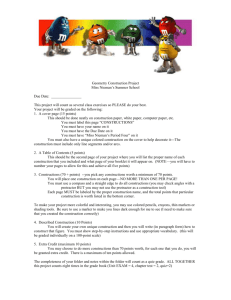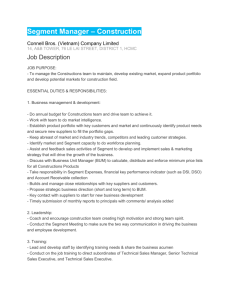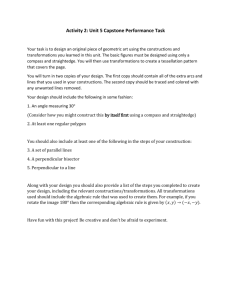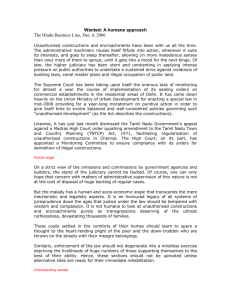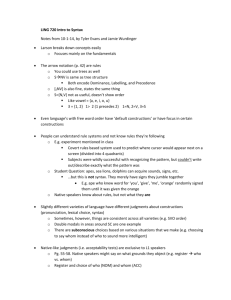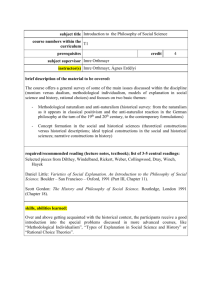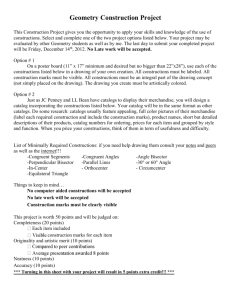WHAT IS NORMAL WHEN WE ARE IMPAIRED:
advertisement
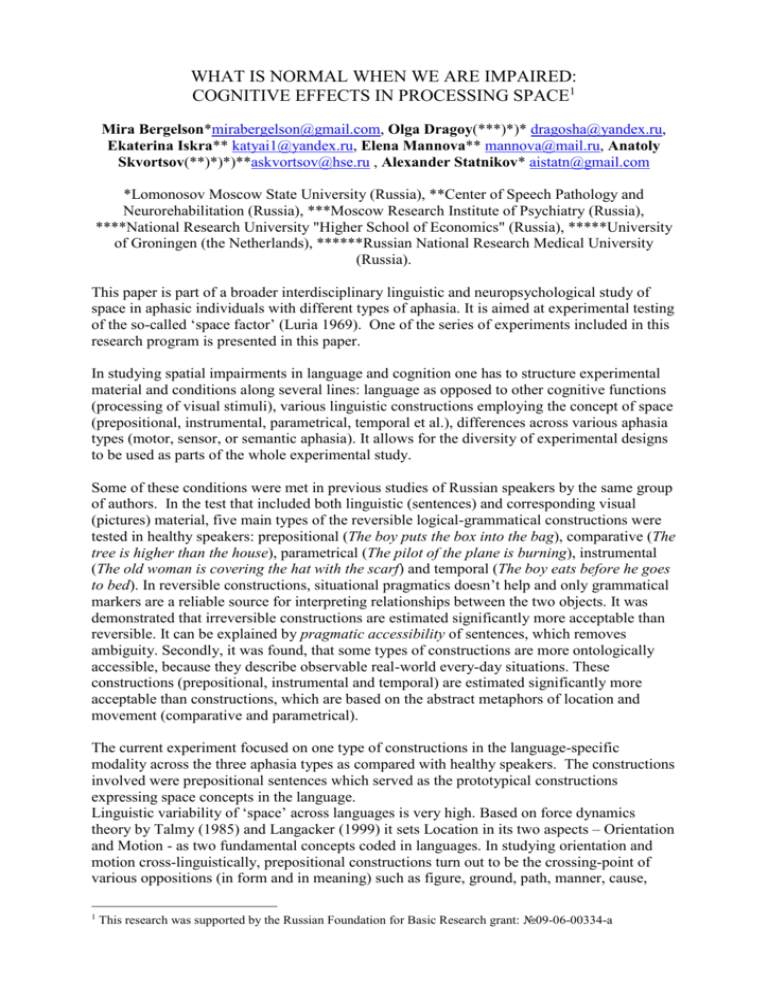
WHAT IS NORMAL WHEN WE ARE IMPAIRED: COGNITIVE EFFECTS IN PROCESSING SPACE1 Mira Bergelson*mirabergelson@gmail.com, Olga Dragoy(***)*)* dragosha@yandex.ru, Ekaterina Iskra** katyai1@yandex.ru, Elena Mannova** mannova@mail.ru, Anatoly Skvortsov(**)*)*)**askvortsov@hse.ru , Alexander Statnikov* aistatn@gmail.com *Lomonosov Moscow State University (Russia), **Center of Speech Pathology and Neurorehabilitation (Russia), ***Moscow Research Institute of Psychiatry (Russia), ****National Research University "Higher School of Economics" (Russia), *****University of Groningen (the Netherlands), ******Russian National Research Medical University (Russia). This paper is part of a broader interdisciplinary linguistic and neuropsychological study of space in aphasic individuals with different types of aphasia. It is aimed at experimental testing of the so-called ‘space factor’ (Luria 1969). One of the series of experiments included in this research program is presented in this paper. In studying spatial impairments in language and cognition one has to structure experimental material and conditions along several lines: language as opposed to other cognitive functions (processing of visual stimuli), various linguistic constructions employing the concept of space (prepositional, instrumental, parametrical, temporal et al.), differences across various aphasia types (motor, sensor, or semantic aphasia). It allows for the diversity of experimental designs to be used as parts of the whole experimental study. Some of these conditions were met in previous studies of Russian speakers by the same group of authors. In the test that included both linguistic (sentences) and corresponding visual (pictures) material, five main types of the reversible logical-grammatical constructions were tested in healthy speakers: prepositional (The boy puts the box into the bag), comparative (The tree is higher than the house), parametrical (The pilot of the plane is burning), instrumental (The old woman is covering the hat with the scarf) and temporal (The boy eats before he goes to bed). In reversible constructions, situational pragmatics doesn’t help and only grammatical markers are a reliable source for interpreting relationships between the two objects. It was demonstrated that irreversible constructions are estimated significantly more acceptable than reversible. It can be explained by pragmatic accessibility of sentences, which removes ambiguity. Secondly, it was found, that some types of constructions are more ontologically accessible, because they describe observable real-world every-day situations. These constructions (prepositional, instrumental and temporal) are estimated significantly more acceptable than constructions, which are based on the abstract metaphors of location and movement (comparative and parametrical). The current experiment focused on one type of constructions in the language-specific modality across the three aphasia types as compared with healthy speakers. The constructions involved were prepositional sentences which served as the prototypical constructions expressing space concepts in the language. Linguistic variability of ‘space’ across languages is very high. Based on force dynamics theory by Talmy (1985) and Langacker (1999) it sets Location in its two aspects – Orientation and Motion - as two fundamental concepts coded in languages. In studying orientation and motion cross-linguistically, prepositional constructions turn out tо be the crossing-point of various oppositions (in form and in meaning) such as figure, ground, path, manner, cause, 1 This research was supported by the Russian Foundation for Basic Research grant: №09-06-00334-а adpositions, verbal and noun forms, systems of coordinates jammed and conflated in the most basic structures employed by a given language. Secondly, prepositional constructions express orientation and motion both prototypically as physical location and/or movement of the human body or other physically observed objects, and metaphorically. The experiment involved 48 prepositional constructions (both reversible and irreversible) describing location in the physical (non-metaphorical) world and paraphrases representing conventional implicatures of the mental picture created by these sentences. Three groups of aphasic individuals diagnosed with motor, sensor/acoustic-mnestic, and semantic aphasia plus a control group of healthy speakers were separately tested. Participants had to choose one of the two paraphrases to the targeted sentence (e.g., sentence The boy is putting the bag into the bucket, paraphrases The bag is hardly visible or The bucket is hardly visible). The accuracy and the time of reaction were measured. The results revealed significant difference in the accuracy and time of reaction in all groups of participants for the reversibility factor. Even healthy participants made more mistakes in reversible constructions. Critically, the reversibility factor interacted with the group factor for healthy individuals and patients with semantic aphasia: in irreversible sentences they made comparable number of mistakes (99% correct in the healthy group and 93% correct in the semantic aphasia group), but individuals with semantic aphasia demonstrated specific decay in interpretation of the reversible constructions within the range of chance level (64% as compared to 88% in the healthy group) . Reversibility factor did not interact with the group factor for the healthy vs individuals with sensor/acoustic mnestic aphasia (64%, 80%) and healthy vs individuals with motor aphasia (66%, 77%). Both sensor/acoustic mnestic and motor groups didn’t show a specific spatial disorder, but demonstrated general decay in processing prepositional constructions. Summing up the accuracy results, individuals with sensor/acoustic mnestic and motor aphasia make more mistakes in reversible than in irreversible constructions, BUT in the same proportion as healthy speakers. They generally make more mistakes. Semantic aphasia patients have a specific spatial disorder as demonstrated by reversible constructions, BUT they don’t differ from the healthy speakers when dealing with irreversible ones. Our data support Luria’s thesis about specific disorder in interpretation of space in reversible (not supported pragmatically) constructions by patients with semantic aphasia and refute the thesis by Goodglass (1993) that reversible constructions are non-specifically impaired in all aphasia types. Importantly, the current experiment provided strong support for the normal pattern of processing reversible and irreversible prepositional constructions in motor and sensor/acoustic-mnestic aphasia, the general decay of their linguistic processing being taken into account. Goodglass H. 1993. Understanding Aphasia. San Diego: Academic Press. Langacker, R. W. 1999. Grammar and Conceptualization. Cognitive Linguistics Research vol. 14. Berlin/New York: Mouton de Gruyter. Luria, A.R. 1969. Higher Cortical Functions in Man. Second Edition, Revised and Expanded. Moscow. Talmy, L. 1985. Force Dynamics in language and thought. Papers from the Regional Meetings, Chicago Linguistic Society, 21. Chicago: University of Chicago Press, , 293–337.
